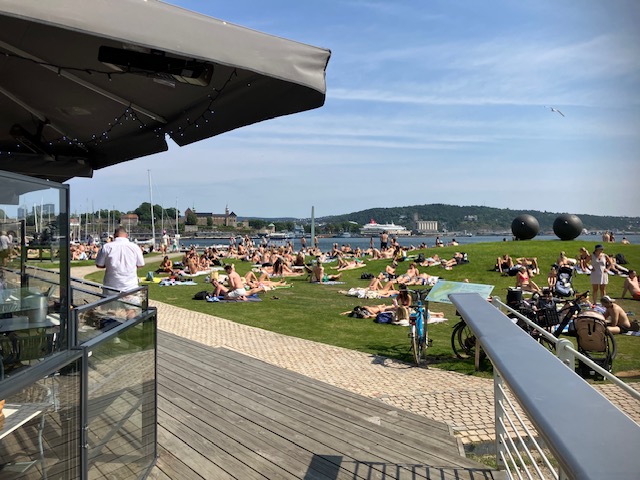Norwegians sweltering through their warmest summer on record have received a message from climate researchers: “Get used to it.” This year’s heat wave is just another sign of the climate change that already has been melting glaciers, setting off floods and shortening the ski season for decades.
 Oslo residents sought refuge from the heat wherever they could, like here on the lawn of the Astrup Fearnley Museum along the fjord in Oslo, PHOTO: NewsinEnglish.no/Nina Berglund
Oslo residents sought refuge from the heat wherever they could, like here on the lawn of the Astrup Fearnley Museum along the fjord in Oslo, PHOTO: NewsinEnglish.no/Nina Berglund
State meteorologists were promising some relief ahead, with temperatures finally dipping after days on end of 30C+ all over the country. Temperatures may fall by as much as 10 degrees in the week ahead, a welcome relief for all those who simply aren’t used to such heat in Scandinavia. The heat wave that began in Southern Europe and reached Norway earlier this month set new records from south to north.
In some cases, official temperatures recorded in Norway were eight to 10 degrees higher than normal for this time of year. Several areas of North Trøndelag had 13 days when thermometers rose over 30C. The historic west coast city of Bergen that attracts lots of tourists and cruiseships recorded two weeks with average temperatures that were the highest since 1861. Thermometers also soared in areas north of the Arctic Circle, with one town in Nordland County recording temperatures over 30C every day for nearly two weeks.
Both Norwegians and tourists alike made the most of it, flocking to local beaches, heading out on boat rides and swimming in fjords and rivers that usually are too cold for most. In Oslo, though, the popular Nobel Peace Center had to close on a few occasions last week because it was simply too warm inside its exhibit rooms. Like many other buildings and most homes in Norway, it has no air conditioning.
Climate researchers warn both locals and visitors that the heat wave is another sign of things to come.
“The extreme warmth in Norway this summer shows clear signs of climate change,” Kristina Dahl of Climate Central, an American research and analysis center, told Norwegian Broadcasting (NRK). Climate change makes heat waves at least three times as probable, she said.
Researcher Bjørn Samset at the Norwegian climate research institution Cicero said the methods used by Climate Central to make such assessments are well-established. “They’re the best developed so far in determining what role climate change has in extreme weather,” Samset told NRK.
Dahl said the abnormally high temperatures pose special health risks in countries like Norway, where people aren’t used to such heat and aren’t as well-equipped to deal with it. Norwegian media outlets have been full of stories about how people have trouble sleeping when it’s still so warm at night along with being so light at this time of the year. Neither homes nor other infrastructure are designed for hot summers, nursing homes face challenges in caring for elderly patients who don’t or won’t drink enough water, and tempers can rise as well.
Samset said Norwegians must expect more summers as warm as this one, perhaps not every year, but much more often than before. Norway has already also experienced relatively extreme droughts like those that that hit local farmers hard a few years ago, along with more torrential rain that sets off flooding.
“Global warming isn’t going away,” Samset said, “and it will get stronger in the decades ahead, so the Summer of 2025 is a clear illustration of how things will be.”
NewsinEnglish.no/Nina Berglund